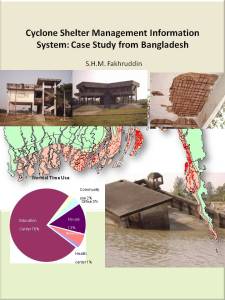 Tropical cyclones accompanied by storm surges are one of the frequent major disasters in Bangladesh. More than 5 million people living in high risk areas) in the coastal belt are extremely vulnerable to cyclonic disaster. The Cyclone of 1970 took 300,000 and 1991 took 139,000 lives; and unaccounted properties. To reduce this risks many cyclone shelters and safe havens were built along the coastal zones. But due to increased population, requirements of numbers of those safe shelters have been increased, at the same time existing shelters were not being managed properly in absence of funds and well fashioned planning. The Government of Bangladesh together with other agencies to date has built about 2033 shelters. Recently, an initiative was taken to accumulate information of these shelters in an organized and accessible database for disaster preparedness, maintenance, planning and prepare management plan for new and existing safe shelters. A survey was carried out to gather physical and management information of the existing shelters for better disaster management and planning, criteria based framework has been developed for decision making by different stakeholders. By using this stand alone software different Government departments can use this for evaluation and maintenance of shelters further improvements, construction of new cyclone shelters, planning for disaster mitigation in the coast, etc. Development partners can use this to prioritize needs and appropriate locations for disaster mitigation. NGOs for risk management plan, evacuation, shelter management, feeding center, targeting emergency response etc. Media will also to extract information on particular shelter, location, capacity etc.
Tropical cyclones accompanied by storm surges are one of the frequent major disasters in Bangladesh. More than 5 million people living in high risk areas) in the coastal belt are extremely vulnerable to cyclonic disaster. The Cyclone of 1970 took 300,000 and 1991 took 139,000 lives; and unaccounted properties. To reduce this risks many cyclone shelters and safe havens were built along the coastal zones. But due to increased population, requirements of numbers of those safe shelters have been increased, at the same time existing shelters were not being managed properly in absence of funds and well fashioned planning. The Government of Bangladesh together with other agencies to date has built about 2033 shelters. Recently, an initiative was taken to accumulate information of these shelters in an organized and accessible database for disaster preparedness, maintenance, planning and prepare management plan for new and existing safe shelters. A survey was carried out to gather physical and management information of the existing shelters for better disaster management and planning, criteria based framework has been developed for decision making by different stakeholders. By using this stand alone software different Government departments can use this for evaluation and maintenance of shelters further improvements, construction of new cyclone shelters, planning for disaster mitigation in the coast, etc. Development partners can use this to prioritize needs and appropriate locations for disaster mitigation. NGOs for risk management plan, evacuation, shelter management, feeding center, targeting emergency response etc. Media will also to extract information on particular shelter, location, capacity etc.
- Comment
- Reblog
-
Subscribe
Subscribed
Already have a WordPress.com account? Log in now.